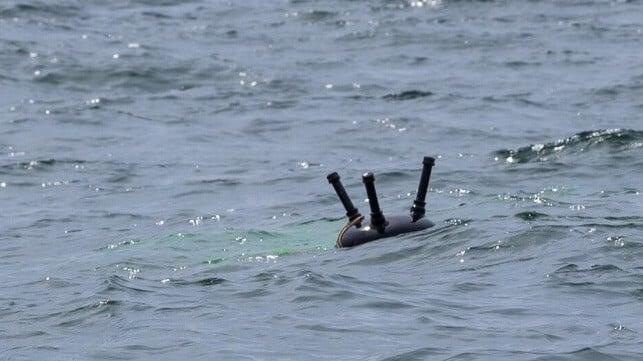Mines Could Protect Taiwan From China - If Installed Quickly Enough

[By David Axe]
If China ever makes good on decades of implicit threats to invade Taiwan, most of its ground force will have to land at ports. Relatively little of it can come over beaches, because they ‘lack purpose-built infrastructure for unloading large transports, and because they are inherently exposed positions,’ Ian Easton noted in a 2021 study for the Project 2049 Institute in Virginia.
Even the advent of China’s new elevated beach landing barges—bespoke pieces of equipment that surprised many observers when they appeared in March—may not significantly improve China’s capacity to unload at Taiwan’s 14 suitable beaches. As ASPI’s Erik Davis wrote last year, almost all are ‘overlooked by terrain that would turn the unloading zones into kill zones.’
Easton says, ‘The success or failure of a future invasion of Taiwan would likely hinge on whether or not Chinese amphibious landing forces are able to seize, hold and exploit the island’s large port facilities.’
Defending the most important ports from a large-scale assault from the sea—there are five ports that Easton concluded are top targets—should be the Taiwanese defence ministry’s main priority. And the most effective weapon for this defence should be obvious.
Mines.
Inexpensive, hard to detect and clear and just as capable of deterring an attack as defeating one, sea mines should be Taiwan’s first maritime line of defence. But it’s not clear Taiwanese leaders appreciate this.
Just a handful of mine strikes could sink enough large transports, and drown enough Chinese sailors and soldiers, to blunt an attack. But the Taiwanese navy simply has too few minelayers to quickly lay minefields outside each targeted port—and to refresh those minefields once they’ve been seeded. Especially considering that Chinese forces will undoubtedly target the minelayers once hostilities commence.
The waters around Taiwan are ideal for mines, said Chris O’Flaherty, a retired Royal Navy captain with deep experience in mine warfare. ‘The conditions of Taiwan are much less conducive to [mine countermeasures] than most areas of the world,’ he explained. There’s ‘a lot of rock, and a lot of fast currents, thus MCM [mine clearing] will be slow.’ And Taiwanese anti-ship missile batteries could complicate any mine-clearing effort by shooting at the ships doing it.
A dense minefield at the entrance to each vulnerable port could deter, delay or defeat a Chinese invasion force—if the Taiwanese navy can get the minefields in place in time. In a sortie lasting several hours, a minelayer with a payload of around 200 mines should be able to fill an area of 800 metres by 800 metres with mines a few tens of metres apart.
But a minefield intended to hold up China indefinitely outside just one port might have to measure several kilometres on each side and contain 3,000 or more mines. Even if three minelayers were available at each port, each would have to make several runs to sea over the course of several days to seed this minefield—and that’s assuming none gets sunk while trying.
The job must be done much more quickly.
Bear in mind, Taiwan can’t lay mines until an invasion is imminent, as the same mines that could protect its ports would also close them to commerce. Taipei’s navy could, in theory, lay mines now—leaving just one unmined channel for vessels to enter and leave a port. But the location of the safe channels couldn’t be kept secret, given how much trade travels on Chinese-flagged ships.
Besides, Beijing may very well view an extensive minelaying effort by Taipei as a justification for an attack.
No, the Taiwanese need to lay their mines right before the Chinese attack. But they have just four Min Jiang-class minelayers in service. Another 10 of the 400-ton vessels are under contract or in the planning stage but won’t join the fleet for several years.
Other Taiwanese warships and even commercial vessels could help lay mines—and they’d need to, given how strained even a 14-vessel minelaying flotilla would be trying to mine the approaches to at least five major ports, quickly and potentially while under fire.
But even an intensive mobilization of available vessels might be inadequate. James Winnefeld, a retired US admiral, called on US forces to prepare to aid a Taiwanese minelaying effort. US submarines could release mines from below. Stealth bombers could drop them from above.
Taipei shouldn’t count on Washington, however—especially given the unpredictability of the United States under President Donald Trump. Neither should Taipei assume that a token minelaying effort would suffice.
After all, Beijing may be willing to accept the loss of many ships and many lives in pursuit of its top foreign-policy objective, incorporation of Taiwan. ‘If you are prepared to take heavy casualties, you can overwhelm the minefield and drive through, accepting all losses of people and equipment,’ O’Flaherty says.
The minefields may have to be dense enough to eliminate an attacking fleet rather than merely damaging and frightening it.
David Axe is a journalist and filmmaker in South Carolina, United States.
This article appears courtesy of The Strategist and may be found in its original form here.
The opinions expressed herein are the author's and not necessarily those of The Maritime Executive.
